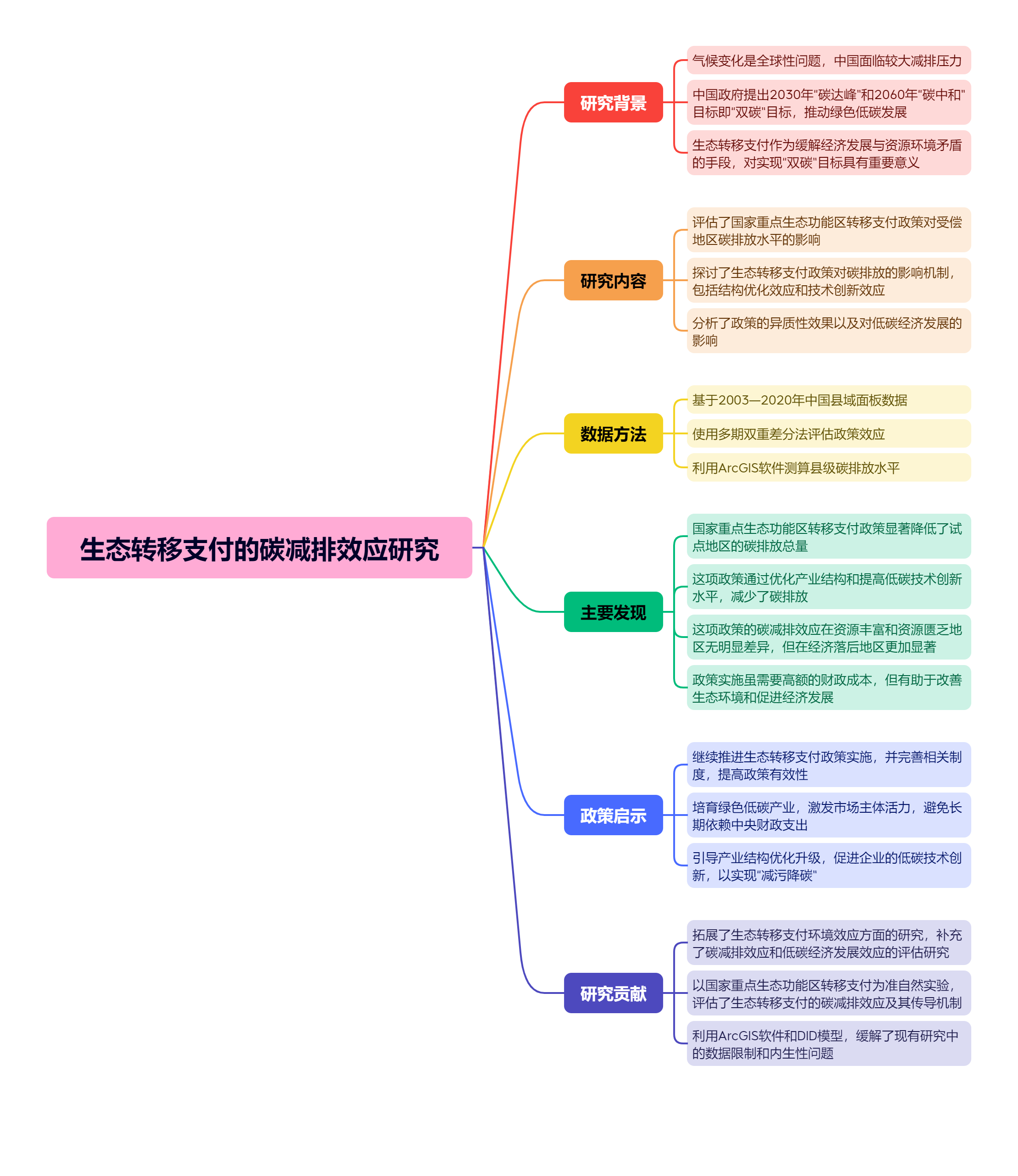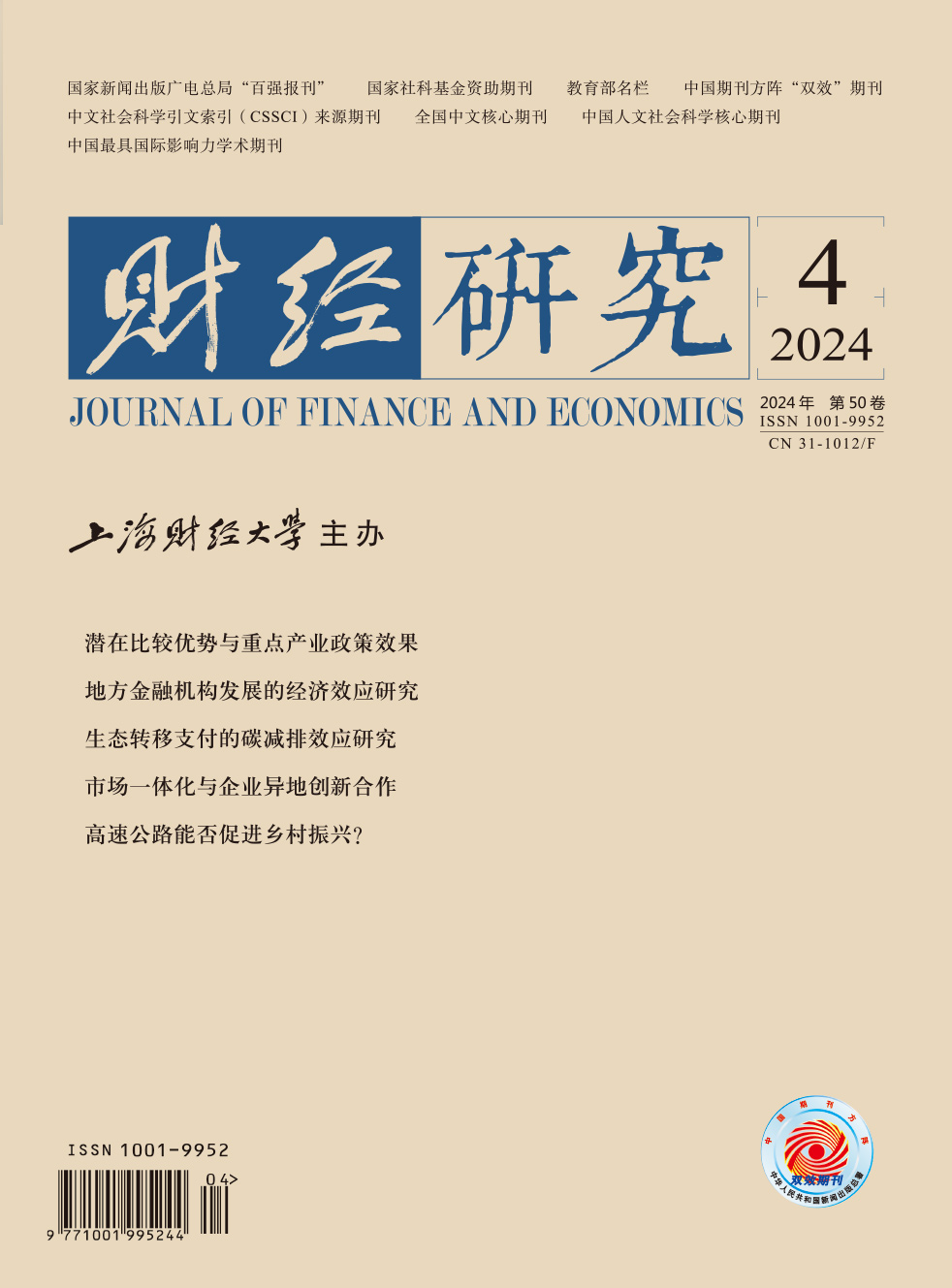生态转移支付有助于缓解经济发展和资源环境之间的矛盾,是推动绿色低碳发展的重要手段。文章以国家重点生态功能区转移支付政策为准自然实验,基于2003—2020年中国县域面板数据,采用多期双重差分法考察了生态转移支付影响受偿地区碳排放水平的效应和作用机制。研究发现:第一,国家重点生态功能区转移支付政策显著降低了试点地区的碳排放总量,这有助于推动该地区绿色低碳发展。与非试点地区相比,该政策的实施使得试点地区的碳排放平均降低约1.90%。第二,机制分析结果表明,该政策能够通过优化产业结构、提高低碳技术创新水平来降低试点地区的碳排放水平,即结构优化效应和技术创新效应。第三,该政策的碳减排效应在资源匮乏地区和资源丰富地区无明显差异,但该政策对经济落后地区碳减排的影响更为显著。第四,成本和收益分析结果表明,尽管生态转移支付政策需要付出高额的财政成本,但这有助于改善生态环境和促进经济发展,进而推动试点地区低碳经济发展。文章的研究结果为健全生态转移支付制度、推动实现“双碳”目标提供理论依据与经验支撑。
生态转移支付的碳减排效应研究——基于国家重点生态功能区转移支付的经验研究
摘要
参考文献
相关附件
思维导图
2 李国平,汪海洲,刘倩. 国家重点生态功能区转移支付的双重目标与绩效评价[J]. 西北大学学报(哲学社会科学版),2014,(1):151−155. DOI:10.3969/j.issn.1000-2731.2014.01.027
5 潘晨,张红梅,祝灵秀,等. 出口的就业与碳排放效应是否平衡——基于价值链分工视角的研究[J]. 中国软科学,2022,(5):76−86. DOI:10.3969/j.issn.1002-9753.2022.05.008
13 Ahmadi Y,Yamazaki A,Kabore P. How do carbon taxes affect emissions? Plant-level evidence from manufacturing[J]. Environmental and Resource Economics,2022,82(2):285−325. DOI:10.1007/s10640-022-00678-x
14 Ahmed V,Zeshan M. Decomposing change in energy consumption of the agricultural sector in Pakistan[J]. Agrarian South:Journal of Political Economy:A triannual Journal of Agrarian South Network and CARES,2014,3(3):369−402. DOI:10.1177/2277976014560944
15 Beck T,Levine R,Levkov A. Big bad banks? The winners and losers from bank deregulation in the United States[J]. The Journal of Finance,2010,65(5):1637−1667. DOI:10.1111/j.1540-6261.2010.01589.x
16 Chen H Y,Hou M Y,Xi Z L,et al. Co-benefits of the national key ecological function areas in China for carbon sequestration and environmental quality[J]. Frontiers in Ecology and Evolution,2023,11:1093135. DOI:10.3389/fevo.2023.1093135
17 Chien F,Hsu C C,Zhang Y Q,et al. Assessing the impact of green fiscal policies and energy poverty on energy efficiency[J]. Environmental Science and Pollution Research,2022,29(3):4363−4374. DOI:10.1007/s11356-021-15854-7
18 Dasgupta P,Srikanth K. Achieving the climate goal with intergovernmental transfers to the forestry sector:Insights from the Indian experience[J]. Climatic Change,2021,164(3-4):45. DOI:10.1007/s10584-021-03016-0
19 Gong C G,Zhang J H,Liu H. Do industrial pollution activities in China respond to ecological fiscal transfers? Evi- dence from payments to national key ecological function zones[J]. Journal of Environmental Planning and Management,2021,64(7):1184−1203. DOI:10.1080/09640568.2020.1813695
20 Goodman-Bacon A. Difference-in-differences with variation in treatment timing[J]. Journal of Econometrics,2021,225(2):254−277. DOI:10.1016/j.jeconom.2021.03.014
21 Hegde R,Bull G Q. Performance of an agro-forestry based payments-for-environmental-services project in Mozambique:A household level analysis[J]. Ecological Economics,2011,71:122−130. DOI:10.1016/j.ecolecon.2011.08.014
22 Jin S T,Jiang A L,Bao B F. Can China’s transfer payment in key ecological function areas reduce the carbon inten- sity? Quasi-natural experimental evidence from Jiangxi,China[J]. Ecological Indicators,2023,154:110537. DOI:10.1016/j.ecolind.2023.110537
23 Li W,Chen Z J,Li M C,et al. Carbon emission and economic development trade-offs for optimizing land-use allocation in the Yangtze River Delta,China[J]. Ecological Indicators,2023,147:109950. DOI:10.1016/j.ecolind.2023.109950
24 Liang Y Y,Yu B Y,Wang L. Costs and benefits of renewable energy development in China’s power industry[J]. Renewable Energy,2019,131:700−712. DOI:10.1016/j.renene.2018.07.079
25 Narassimhan E,Gallagher K S,Koester S,et al. Carbon pricing in practice:A review of existing emissions trading systems[J]. Climate Policy,2018,18(8):967−991. DOI:10.1080/14693062.2018.1467827
26 Ring I. Integrating local ecological services into intergovernmental fiscal transfers:The case of the ecological ICMS in Brazil[J]. Land Use Policy,2008,25(4):485−497. DOI:10.1016/j.landusepol.2007.11.001
27 Santos R,Ring I,Antunes P,et al. Fiscal transfers for biodiversity conservation:The Portuguese local finances law[J]. Land Use Policy,2012,29(2):261−273. DOI:10.1016/j.landusepol.2011.06.001
28 Shi B B,Li N,Gao Q,et al. Market incentives,carbon quota allocation and carbon emission reduction:Evidence from China’s carbon trading pilot policy[J]. Journal of Environmental Management,2022,319:115650. DOI:10.1016/j.jenvman.2022.115650
29 Wang H,Li Y Y,Lin W F,et al. How does digital technology promote carbon emission reduction? Empirical evidence based on e-commerce pilot city policy in China[J]. Journal of Environmental Management,2023,325:116524. DOI:10.1016/j.jenvman.2022.116524
30 Wang Q W,Chiu Y H,Chiu C R. Driving factors behind carbon dioxide emissions in China:A modified production-theoretical decomposition analysis[J]. Energy Economics,2015,51:252−260. DOI:10.1016/j.eneco.2015.07.009
31 Yang J L,Dong J W,Xiao X M,et al. Divergent shifts in peak photosynthesis timing of temperate and alpine grasslands in China[J]. Remote Sensing of Environment,2019,233:111395. DOI:10.1016/j.rse.2019.111395
32 Zhang X F,Fan D C. Collaborative emission reduction research on dual-pilot policies of the low-carbon city and smart city from the perspective of multiple innovations[J]. Urban Climate,2023,47:101364. DOI:10.1016/j.uclim.2022.101364
引用本文
杨秋月, 刘萧萧, 李佐军. 生态转移支付的碳减排效应研究——基于国家重点生态功能区转移支付的经验研究[J]. 财经研究, 2024, 50(4): 34-48.
导出参考文献,格式为:
上一篇:新质生产力的思想创新脉络





 1755
1755  2243
2243


